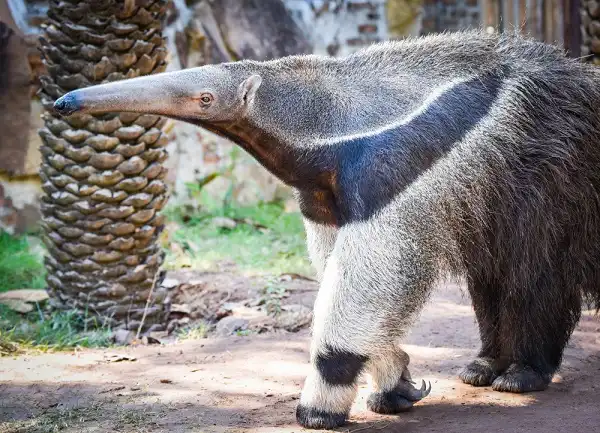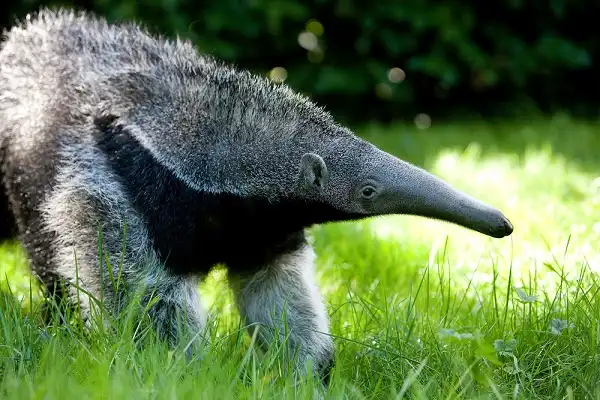We’ve all heard many unique and interesting stories surrounding anteaters, although they are not as common a sight in our day-to-day lives. Despite their scarcity, these well-adapted animals have much to offer us in terms of an understanding of their behavior and the environments they inhabit. In this blog post, we will be exploring the anatomy, physiology, diet, habitat, and more about the fascinating anteater!

Anteater Description
Anteaters are fascinating creatures that belong to the Xenarthra order, meaning “strange joints.” They have long and slender snouts that are perfect for sniffing out ants and termites, which make up their primary diet. Their tongues can extend up to two feet long, and they can flick their tongues in and out up to 160 times per minute to capture insects. Anteaters have long, curved claws that are used to dig into ant mounds and termite nests. Despite their sharp claws, they are not aggressive animals, and their poor eyesight makes them more reliant on their sense of smell to navigate their surroundings. They have a keen sense of hearing, which helps them locate prey and avoid predators..
Anteater Habitat
Anteaters are remarkable creatures that are well-adapted to the environments in which they live. They are found in a variety of habitats throughout Central and South America, including grasslands, rainforests, and savannas. Each species of anteater has its own preferred habitat. For example, giant anteaters thrive in open grasslands and savannas, while southern tamanduas are more commonly found in tropical rainforests. Silky anteaters are known for their preference for higher elevations, where they can find cooler temperatures and an ample food supply. Despite their preference for certain habitats, anteaters are remarkably adaptable creatures. They can survive in a range of environments, from the scrublands of Uruguay and Argentina to the thick forests of Brazil and Ecuador. In areas where their natural habitats have been disrupted or destroyed, they have even been known to adapt to human environments such as farms and plantations.
Anteater Diet
Anteaters are remarkable creatures with an equally remarkable diet. Their physiological structure is perfectly adapted to their unique diet, which consists mostly of ants and termites. Anteaters are known to consume up to 30,000 insects per day, making them an essential component of their ecosystem. They play a crucial role in controlling insect populations, which can otherwise cause significant damage to crops and other vegetation. Their diet of mainly ants and termites also means that they are mostly found in warm and humid regions that are abundant with these insects. Despite their primary diet of ants and termites, anteaters have also been observed consuming other types of insects such as beetles, moths, and even soft-bodied maggots. Some species of anteaters have also been known to supplement their diet with fruit, which they find by smell and sight rather than through their specialized tongue.

Anteater Size
Anteaters are fascinating creatures, not only because of their unique diet and habits but also because of their physical characteristics. These animals can vary in size depending on their species, with the smallest being the silky anteater, which only measures around 40 centimeters in length, and the largest being the giant anteater, which can grow up to 2 meters in length and weigh up to 50 kilograms. The physical appearance of these animals is also striking. They have long, slender bodies with short legs, and a distinctive snout that houses their elongated tongue. Their fur is coarse and bristly, ranging from light brown to almost black. Some species, like the silky anteater, have a mane of fur that runs down their back. Despite their size differences, all anteaters have adapted to their specific environments. For example, the silky anteater is well-suited for life in the trees, using its prehensile tail to grasp onto branches while it searches for food. The giant anteater, on the other hand, has strong legs and large claws that it uses to dig into termite mounds and ant nests.
Anteater Lifespan
Anteaters are known for their unique diet, feeding habits, and physical appearance, but their lifespan is another aspect that is not commonly discussed. The lifespan of an anteater varies depending on the species, with the average lifespan ranging from 12 to 15 years in the wild and up to 25 years in captivity. The lifespan of an anteater is influenced by a variety of factors, such as their environment, diet, and genetic makeup. Anteaters living in the wild may face more challenges to their health and survival, such as environmental threats, predators, and disease. In captivity, anteaters benefit from better nutrition and veterinary care, which can potentially extend their lifespan. Anteaters are also known to have low reproductive rates, which can also impact their lifespan. Females usually give birth to a single offspring at a time, and the gestation period can last up to six months. The juvenile anteater stays with its mother for up to two years before becoming independent, and females may only reproduce every two to three years. This slow reproductive rate can limit the population growth of anteaters, making them more susceptible to environmental and human-induced threats.
Anteater Behavior
Anteaters are known for their unique physical features and diet. However, their behavior is also fascinating and worth discussing. Anteaters are mostly solitary animals and do not form large social groups. They are primarily active during the night and spend most of their day sleeping in burrows or tree hollows. During the night, they leave their sleeping quarters to forage for food, covering a distance of up to 10 kilometers in search of their next meal. While they are not aggressive animals, anteaters can be territorial and will defend their home range from other anteaters. They use their claws to mark their territory and leave scent trails using glandular secretions. When threatened, anteaters will stand their ground and use their long, sharp front claws for defense. Another interesting aspect of anteater behavior is their vocalizations. Although they are mostly silent animals, they can produce a variety of sounds, such as grunts, huffs, and snorts, to communicate with other anteaters. Anteaters also have unique reproductive behaviors.

Anteater Speed
Anteaters are not known for their speed, as they are primarily slow-moving animals. However, they are adapted to move quickly and efficiently in their environments. Their long legs and strong claws allow them to move quickly and efficiently over rough terrains, such as forest floors and rocky surfaces. Despite their generally slow speed, anteaters can sprint at surprising speeds when threatened. They can reach speeds of up to 30 miles per hour, making them one of the fastest animals in their weight class. Their powerful legs and strong muscles enable them to accelerate quickly and evade predators, such as jaguars and pumas. Overall, while they are not the fastest animals in their environments, anteaters are well-adapted to move quickly and efficiently when necessary. Their physical abilities, combined with their unique behavioral patterns, allow them to navigate their environments and evade threats while maximizing their energy expenditure. So, anteaters can also be considered as efficient runners and climbers in their respective habitats.
Anteater Hunting
Anteaters are not traditional hunters, as they primarily rely on their diet of ants and termites. However, they do exhibit unique hunting behaviors and adaptations that allow them to efficiently locate and gather their preferred food sources. The anteater’s sense of smell is also crucial for their hunting success. They have an extraordinary sense of smell, with over 40 times the number of olfactory receptors as humans, which allows them to locate ants and termites with great precision. They can detect the chemicals and pheromones emitted by their prey, even from a considerable distance away. Another key hunting behavior of the anteater is their destruction of ant and termite mounds. They use their powerful front claws to tear open the hard exteriors of the nests, allowing them to access the soft, protein-rich interior. This behavior not only provides the anteater with a meal but also prevents the nests from becoming too large and causing damage to the environment.
Anteater Reproduction
Anteaters reproduce through the process of mating and giving birth. Mating typically occurs during the wet season, when anteaters are more active and food is plentiful. The female will give birth to 1 or 2 babies after a gestation period of around six months. These babies, called “pups”, are born blind, deaf, and toothless – relying completely on their mother for sustenance. The pups will stay with their mother until they reach adulthood at approximately 18 months old. During this time, she will teach the pup how to hunt properly using its tongue and claws.
Anteaters’ Predators and Threats
Anteaters are preyed upon by a variety of predators, including large cats such as jaguars and ocelots, birds of prey, and snakes. Man-made threats also pose a serious danger to anteaters due to deforestation, hunting for bushmeat, and habitat destruction. As their natural habitats shrink and become more fragmented, anteaters face an increased risk of becoming locally extinct in some areas. Conservation efforts are necessary if we wish to protect these interesting animals from extinction. Anteater populations can be protected through habitat protection and preservation measures such as sustainable forestry practices or the creation of wildlife corridors that allow them to travel safely between separate areas of forests. Additionally, laws that prohibit the hunting or trafficking of bushmeat are essential for the protection of anteaters.

Conclusion
Anteaters are fascinating animals, possessing an array of physical and behavioral adaptations that allow them to be efficient hunters and runners. Their long tongues, powerful claws, keen sense of smell, and tree-climbing abilities enable them to quickly access their preferred food sources and evade predators. By controlling ant and termite populations, anteaters also play an important role in maintaining the balance of their habitats. Therefore, we can appreciate these unique animals for the valuable contributions they make to our ecosystems.
Frequently Asked Question


